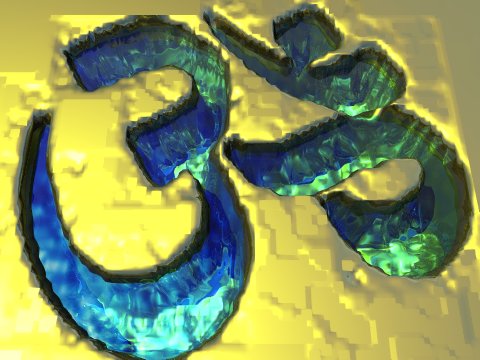
Journal Articles: Hinduism OCRT: Hinduism
Buy CD-ROM Buy books about Hinduism

|
Hinduism |
The Vedas
There are four Vedas, the Rig Veda, Sama Veda, Yajur Veda and Atharva Veda. The Vedas are the primary texts of Hinduism. They also had a vast influence on Buddhism, Jainism, and Sikhism. Traditionally the text of the Vedas was coeval with the universe. Scholars have determined that the Rig Veda, the oldest of the four Vedas, was composed about 1500 B.C., and codified about 600 B.C. It is unknown when it was finally committed to writing, but this probably was at some point after 300 B.C.
The Vedas contain hymns, incantations, and rituals from ancient India. Along with the Book of the Dead, the Enuma Elish, the I Ching, and the Avesta, they are among the most ancient religious texts still in existence. Besides their spiritual value, they also give a unique view of everyday life in India four thousand years ago. The Vedas are also the most ancient extensive texts in an Indo-European language, and as such are invaluable in the study of comparative linguistics.
Rig Veda
![]() The Rig-Veda
The Rig-Veda
translated by Ralph Griffith [1896]
A complete English translation of the Rig Veda.
![]() Rig-Veda (Sanskrit)
Rig-Veda (Sanskrit)
The complete Rig Veda in Sanskrit, in Unicode Devanagari script and standard romanization.
Hymns to the Maruts, Rudra, Vâyu and Vâta, tr. by F. Max Müller [1891]
A masterpiece of linguistics and comparative mythology: translations and deep analysis of the Vedic Hymns to the Storm Gods.
Hymns to Agni, tr. by Hermann Oldenberg [1897]
The Vedic Hymns to Agni.
![]() A Vedic Reader for Students (excerpts)
A Vedic Reader for Students (excerpts)
by A.A. Macdonell [1917]
An introduction to the Dramatis Personæ of the Rig Veda.
Sama Veda
![]() The Sama-Veda
The Sama-Veda
translated by Ralph Griffith [1895]
A collection of hymns used by the priests during the Soma sacrifice.
Many of these duplicate in part or in whole hymns from the Rig Veda.
This is a complete translation.
Yajur Veda
![]() The Yajur Veda (Taittiriya Sanhita)
The Yajur Veda (Taittiriya Sanhita)
translated by Arthur Berriedale Keith [1914]
A complete translation of the Black Yajur Veda.
The Yajur Veda is a detailed manual of the Vedic sacrificial rites.
![]() The Texts of the White Yajurveda
The Texts of the White Yajurveda
translated by Ralph T.H. Griffith [1899]
A complete translation of the White Yajur Veda.
Atharva Veda
The Atharva Veda also contains material from the Rig Veda, but of interest are the numerous incantations and metaphysical texts, which this anthology (part of the Sacred Books of the East series) collects and categorizes. The Atharva Veda was written down much later than the rest of the Vedas, about 200 B.C.; it may have been composed about 1000 B.C.
translated by Ralph T.H. Griffith [1895-6]
The unabridged Atharva Veda translation by Ralph Griffith.
translated by Maurice Bloomfield [1897]
(Sacred Books of the East, Vol. 42)
The Sacred Books of the East translation of the Atharva-veda. Selected hymns from the Atharva-veda.
Upanishads
The Upanishads are a continuation of the Vedic philosophy, and were written between 800 and 400 B.C. They elaborate on how the soul (Atman) can be united with the ultimate truth (Brahman) through contemplation and mediation, as well as the doctrine of Karma-- the cumulative effects of a persons' actions.
![]() The Upanishads
(Sacred Books of the East, vols. 1 and 15):
The Upanishads
(Sacred Books of the East, vols. 1 and 15):
Max Müller, translator [1879]
Max Müller, translator [1884]
Puranas
The Puranas are post-Vedic texts which typically contain a complete narrative of the history of the Universe from creation to destruction, genealogies of the kings, heroes and demigods, and descriptions of Hindu cosmology and geography. There are 17 or 18 canonical Puranas, divided into three categories, each named after a deity: Brahma, Vishnu and Shiva. There are also many other works termed Purana, known as 'Upapuranas.'
![]() The Vishnu Purana
The Vishnu Purana
by H.H. Wilson [1840]
A primary text of the Vaishnava branch of Hinduism, and one of the canonical Puranas of the Vishnu category.
Among the portions of interest are a cycle of legends of the
boyhood deeds of Krishna and Rama.
H.H. Wilson was one of the first Europeans to translate a Hindu
sacred text from the original Sanskrit.
His style and annotations are exceptional and very readable.
![]() The Garuda Purana
The Garuda Purana
translated by Ernest Wood and S.V. Subrahmanyam [1911]
A Vishnu Purana with Dantesque descriptions of the afterlife, and details of Hindu funeral rites.
![]() The S'rimad Devî Bhâgawatam
The S'rimad Devî Bhâgawatam
translated by Swami Vijnanananda (Hari Prasanna Chatterji) [1921]
One of the Upapuranas, devoted to the Devi (Goddess).
![]() The Devî Gita
The Devî Gita
translated by Swami Vijnanananda (Hari Prasanna Chatterji) [1921]
The Song of the Goddess.
An excerpt from the S'rimad Devî Bhâgawatam (above)
![]() The Prem Sagur
The Prem Sagur
(Prem Sagar) by Lallu Lal, translated by W. Hollings [1848]
English translation of a popular Hindi retelling of the
Krishna cycle, based on the tenth book of the Bhagavata Purana.
![]() The Transmigration of the Seven Brahmans
The Transmigration of the Seven Brahmans
translated by Henry David Thoreau [1931]
An excerpt from the Harivamsa, a Puranic text, translated by the American transcendentalist philosopher.
![]() Kundalini: The Mother of the Universe
Kundalini: The Mother of the Universe
by Rishi Singh Gherwal [1930]
Includes an English translation of the Lalita Sahasranama, the 'Thousand Names of the Goddess,' from the Brahmanda Purana.
Other Primary Texts
![]() The Laws of Manu
The Laws of Manu
George Bühler, translator [1886]
(Sacred Books of the East, vol. 25)
Manu was the legendary first man, the Adam of the Hindus. This is a collection of laws attributed to Manu.
![]() The Sacred Laws of the Âryas, Part I (SBE 2)
The Sacred Laws of the Âryas, Part I (SBE 2)
George Bühler translator [1879]
(Sacred Books of the East, Vol. 2)
Hindu law books written by the sages Âpastamba and Gautama, in the first millenium B.C.
![]() The Sacred Laws of the Âryas, Part II (SBE 14)
The Sacred Laws of the Âryas, Part II (SBE 14)
George Bühler translator [1879]
(Sacred Books of the East, Vol. 14)
Hindu law books written by the sages Vasishtha and Baudhâyana,
in the first millenium B.C.
![]() The Institutes of Vishnu (SBE 7)
The Institutes of Vishnu (SBE 7)
Julius Jolly, translator [1880]
(Sacred Books of the East, Vol. 7)
This Hindu law book contains descriptions of yogic practises, and a moving hymn to the Goddess Prajapati.
![]() The Minor Law Books (SBE 33)
The Minor Law Books (SBE 33)
Julius Jolly, translator [1880]
(Sacred Books of the East, Vol. 33)
Later Hindu law books written by Narada and Brihaspati about 600 CE.
![]() The Satapatha Brahmana
The Satapatha Brahmana
A primary source for Vedic-era mythology, philosophy and magical practices.
The complete five part Sacred Books of the East
Satapatha Brahmana translation is now online:
![]() Satapatha Brahmana, Part I (SBE12)
Satapatha Brahmana, Part I (SBE12)
![]() Satapatha Brahmana, Part II (SBE26)
Satapatha Brahmana, Part II (SBE26)
![]() Satapatha Brahmana, Part III (SBE41)
Satapatha Brahmana, Part III (SBE41)
![]() Satapatha Brahmana, Part IV (SBE43)
Satapatha Brahmana, Part IV (SBE43)
![]() Satapatha Brahmana, Part V (SBE44)
Satapatha Brahmana, Part V (SBE44)
Hermann Oldenberg, tr. [1886]
Hermann Oldenberg, tr. [1892]
Ancient Hindu household rites, including fertility, marriage, purity, initiations, and funerals.
The Epics
The Mahabharata and Ramayana are the national epics of India. They are probably the longest poems in any language. The Mahabharata, attributed to the sage Vyasa, was written down from 540 to 300 B.C. The Mahabharata tells the legends of the Bharatas, a Vedic Aryan group. The Ramayana, attributed to the poet Valmiki, was written down during the first century A.D., although it is based on oral traditions that go back six or seven centuries earlier. The Ramayana is a moving love story with moral and spiritual themes that has deep appeal in India to this day.
In addition, a key Hindu sacred text, the Bhagavad Gita, is embedded in Book Six of the Mahabharata.
Mahabharata
translated by Kisari Mohan Ganguli [1883-1896]
Digitizing this unabridged translation of the Mahabharata was a joint venture between sacred-texts and Project Gutenberg.
![]() The Mahabharata in Sanskrit
The Mahabharata in Sanskrit
The text of the Mahabharata with parallel Devanagari and Romanization Unicode.
The Ramayana
![]() Rámáyan Of Válmíki
Rámáyan Of Válmíki
translated by Ralph T. H. Griffith [1870-1874]
The first complete public domain translation of the Ramayana to be placed online.
![]() The Ramayana in Sanskrit
The Ramayana in Sanskrit
The text of the Ramayana with parallel Unicode Devanagari and Romanization.
Abridged Versions
![]() The Ramayana and Mahabharata
The Ramayana and Mahabharata
R. Dutt translator [1899]
A very readable abridged version of these epics.
![]() Indian Idylls
Indian Idylls
Sir Edwin Arnold, translator [1883]
More stories from the Mahabharata, rendered in poetry.
![]() Love and Death
Love and Death
by Sri Arobindo [1921]
The popular story of Ruru and Priyumvada from the Mahabharata.
Bhagavad Gita
The Bhagavad Gita, usually considered part of the sixth book of the Mahabharata (dating from about 400 or 300 B.C.), is a central text of Hinduism, a philosphical dialog between the god Krishna and the warrior Arjuna. This is one of the most popular and accessible of all Hindu scriptures, required reading for anyone interested in Hinduism. The Gita discusses selflessness, duty, devotion, and meditation, integrating many different threads of Hindu philosophy.
![]() The Bhagavadgîtâ (SBE 8)
The Bhagavadgîtâ (SBE 8)
with the Sanatsugâtîya and the Anugîtâ
translated by Kâshinâth Trimbak Telang,
(Sacred Books of the East, Vol. 8) [1882]
A scholarly prose translation of the Bhagavad Gita
with two other similar, less well known, works from the Mahabharata.
![]() The Bhagavad Gita in Sanskrit
The Bhagavad Gita in Sanskrit
A Unicode presentation of the Gita in Romanized Sanskrit.
![]() Srimad-Bhagavad-Gita
Srimad-Bhagavad-Gita
by Swami Swarupananda [1909]
A modern English prose translation of the Gita with commentary.
The Bhagavad Gita
A modern prose translation of the Gita, sanctioned by the International Gita Society.
![]() The Bhagavad Gita
The Bhagavad Gita
Sir Edwin Arnold, translator [1885]
A classic poetic version of the Gita.
Vedanta
![]() The Vedântâ-Sûtras (SBE 48)
The Vedântâ-Sûtras (SBE 48)
with commentary by Râmânuja,
translated by George Thibaut;
(Sacred Books of the East, Vol. 48)
[1904]
![]() The Vedântâ-Sûtras Part I (SBE 34)
The Vedântâ-Sûtras Part I (SBE 34)
with commentary by Sankarâkârya,
translated by George Thibaut;
(Sacred Books of the East, Vol. 34)
[1890]
![]() The Vedântâ-Sûtras Part II (SBE 38)
The Vedântâ-Sûtras Part II (SBE 38)
with commentary by Sankarâkârya,
translated by George Thibaut;
(Sacred Books of the East, Vol. 38)
[1896]
![]() The Crest-Jewel of Wisdom
The Crest-Jewel of Wisdom
and other writings of Śankarâchârya;
translation and commentaries by Charles Johnston
[1946]
Later Texts
![]() The Yoga Sutras of Patanjali
by Charles Johnston [1912]
The Yoga Sutras of Patanjali
by Charles Johnston [1912]
This concise work describes an early stage in the philosophy and practise of Yoga.
Dating from about 150 B.C., the work shows dualist and Buddhist influences.
Required reading if you are interested in Yoga or meditation.
![]() The Yoga Sutras of Patanjali
The Yoga Sutras of Patanjali
Another translation of this classic text of Yoga.
![]() The Hatha Yoga Pradipika
The Hatha Yoga Pradipika
translated by Pancham Sinh [1914]
The oldest extant work about Hatha Yoga, including the full Sanskrit text.
![]() The Sánkhya Aphorisms of Kapila
The Sánkhya Aphorisms of Kapila
translated by James R. Ballantyne [1885]
![]() Kalidasa: Translations of Shakuntala and Other Works
Kalidasa: Translations of Shakuntala and Other Works
by Kalidasa, (fifth century C.E.),
tr. by Arthur W. Ryder [1914]
The master dramas of the 'Shakespeare of India,' including Shakuntala.
![]() The Little Clay Cart
The Little Clay Cart
by Shudraka
tr. by Arthur W. Ryder [1905]
The earliest Indian drama, a screwball comedy of manners, with a cast of courtesans, kings and scoundrels.
![]() Verses of Vemana
Verses of Vemana
by Vemana (17th century),
tr. from the Telugu by C.P. Brown [1829]
Verses of devotion by a Dravidian South Indian poet.
![]() Black Marigolds
Black Marigolds
(Caurapañcāśikā) by Bilhana, tr. by Edward Powys Mathers [1919]
A free verse translation of Bilhana, an 11th century Kashmiri poet.
![]() Vikram and the Vampire
Vikram and the Vampire
tr. by Sir Richard Burton. [1870]
Tales of a Vampire Scheherazade.
![]() Songs of Kabîr
Songs of Kabîr
Kabir, tr. by Rabindranath Tagore, Introduction by Evelyn Underhill;
New York, The Macmillan Company; [1915]
Kabir's mystical and devotional poetry has been found inspirational by people of many different faiths.
Kabir tried to find common ground between Hindus and Muslims.
![]() Yoga Vashisht or Heaven Found
Yoga Vashisht or Heaven Found
by Rishi Singh Gherwal [1930]
Excerpts from the shorter Yoga Vasishta
![]() The Vimanika Shastra
The Vimanika Shastra
tr. by G.R. Josyer [1973]
An ancient Sanskrit text about UFOs--or is it?
Modern Books
![]() Relax with Yoga
Relax with Yoga
by Arthur Liebers [1960]
An introduction to modern Raja Yoga, with photos of asanas.
![]() Great Systems of Yoga
Great Systems of Yoga
by Ernest Wood [1954]
A review of the Yogic systems.
![]() Old Deccan Days
Old Deccan Days
by Mary Frere [1868]
![]() Râmakrishna, His Life and Sayings
Râmakrishna, His Life and Sayings
by F. Max Müller [1898]
The collected words of the Hindu sage from a humble background who transcended arbitrary religious boundaries.
![]() How To Be A Yogi
How To Be A Yogi
by Swâmi Abhedânanda [1902]
A road-map of the Yogic schools.
![]() Twenty-two Goblins
Twenty-two Goblins
by Arthur W. Ryder [1912]
![]() Indian Fairy Tales
Indian Fairy Tales
by Joseph Jacobs [1912]
![]() Indian Myth and Legend
Indian Myth and Legend
by Donald A. Mackenzie [1913]
Hindu mythology from the earliest times through the Mahabharata and Rayamaya.
![]() Hindu Mysticism
Hindu Mysticism
by S.N. Dasgupta [1927]
![]() Writings of Sister Nivedita (Margaret E. Noble)
Writings of Sister Nivedita (Margaret E. Noble)
by Sister Nivedita (Margaret E. Noble) [1900]
by Sister Nivedita (Margaret E. Noble) [1904]
by Sister Nivedita (Margaret E. Noble) [1913]
![]() Writings of Rabindranath Tagore
Writings of Rabindranath Tagore
![]() The Indian Stories of F.W. Bain
The Indian Stories of F.W. Bain
Also of Interest
![]() Journal articles: Hinduism
Journal articles: Hinduism
![]() Sacred Sexuality
Kama Sutra, Ananga Ranga, and more.
Sacred Sexuality
Kama Sutra, Ananga Ranga, and more.
![]() Sanskrit dictionary
Sanskrit dictionary
Also refer to Sanskrit resources at WordGumbo.com [External Site]
Links
Autobiography of a Yogi by Paramhansa Yogananda [1946] [External Site]|
|
|
|




